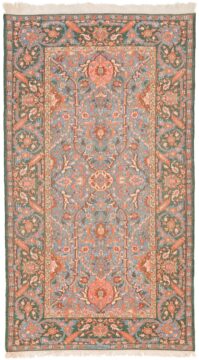
A large collection of Persian carpets made using traditional hand-spun and plant-dyed techniques.
At the Seiko House Ginza Hall, from July 8th (Sat) to 17th (Mon), you can enjoy the classic pattern carpet woven in the royal workshop and the tribal pattern carpet of the nomads. Colorful Persian Beauty – Handspun and Vegetable Dyed Carpet Exhibition" will be held.
In this exhibition, the venue is divided into two spaces, and you can enjoy the contrast of the beauty and charm of each of the classic patterns that can be seen in the dimmed lighting and the tribal patterns that can be seen in natural light.
The classic pattern of the solemn and gorgeous style of the carpet woven in the royal workshop is characterized by the powerful and profound colors dyed using natural dyes such as madder, indigo, and walnut skin.
On the other hand, tribal patterned carpets, which were born from the nomadic people's coexistence with nature, have become established as a daily living tool for nomads.
The culture of cities and nomads is Persian civilization itself, and it is rich in diversity in terms of patterns, colors, and meanings.
Carpets woven from carefully selected wool are highly elastic and durable, and the more they are stepped on, the more their texture and luster appear. increase.

Solemaniye Phini Workshop Banafsheh Tax included ¥1,870,000 (100% silk, 141×79 cm, production area: Azerbaijan region)
A very finely woven vine weave carpet, dyed with vegetable dyes, is applied to the ground silk. The motif of the date palm, which is considered to be a sacred tree, is woven with a palmetto pattern that combines the sacred lotus flower and the pomegranate, which means the prosperity of descendants. A beautiful carpet full of freshness like summer.
Livestock (goats and sheep) familiar to nomads, birds, and one-humped camels living in Iran are woven together with children to create a nomadic carpet. The gentle colors of plant dyes and the lovely design will soothe your heart.
Camels are said to represent wealth and property because they carry tools and important things for nomads. The pattern of continuous triangles on the edge of the carpet means an amulet and seems to protect the world drawn in the carpet. The green color of the background, which is created by layering yellow and indigo, is reminiscent of a rich grassland.
[What is Solemaniye Phini Koubou]
A masterpiece of Kashan in central Iran, which was produced in the royal workshop during the golden age of Persian carpets, has been revived for the first time in 100 years using traditional techniques of hand spinning and plant dyeing. Due to this achievement, it has been selected as the carpet used in the UNESCO Intangible Cultural Heritage "Carpet Washing Festival" held in Kashan. In addition, it is the only one in modern times that has inherited the technique of pearl weaving, which is said to be a phantom weave. In 2022, we received an order for a Persian carpet from Takayama for the Gion Festival in Kyoto, together with Mealy Kobo, and produced it.
[What is Mealy Koubou]
With the emphasis on mass production and the spread of chemical dyes, traditional vegetable dyed carpets are disappearing, Lazi Mealy, the 5th generation owner of the Mealy workshop founded in 1820, creates rare weaves and The pattern was revived in the present age. Mealy's carpets are in the collections of the Victoria and Albert Museum in London, the Tehran Carpet Museum, and in Japan, the Orient Museum of Okayama and the Kyushu National Museum.
"Persian Beauty Colored by Light and Shadow -Hand-Spun and Plant-Dyed Carpet Exhibition-"
July 8th (Sat) – 17th (Mon)
Venue: Seiko House Ginza Hall Seiko House Ginza 6th floor, 4-5-11 Ginza, Chuo-ku, Tokyo
Inquiries: Wako Main Store Basement (03) 3562-2111 (representative)
Business hours: 11:00-19:00 (until 17:00 on the last day)
Closed: Open all year round Admission: Free Sponsor/Wako
◎ Wako Hall has changed its name to "Seiko House Ginza Hall".
We will send various messages to the world, such as exhibitions related to the Seiko Group business in general and co-creation with artists.
Business hours and events are subject to change without notice.
Please see our website for the latest information.
home page
https://www.wako.co.jp
Instagram
https://www.instagram.com/wako_ginza_tokyo/
Instagram for lifestyle
https://www.instagram.com/lifestyle_wako_ginza_tokyo/
[Wako Co., Ltd.] From the press release
<Related articles in the past>
"The art of time" spun by actors and craftsmen. The Seiko Group will hold an exhibition of costumes by Tamasaburo Bando, titled “Four Seasons, Nature, and Life – Transition of Time and Natural Beauty –” at Seiko House Ginza Hall in Ginza 4-chome (free admission).


